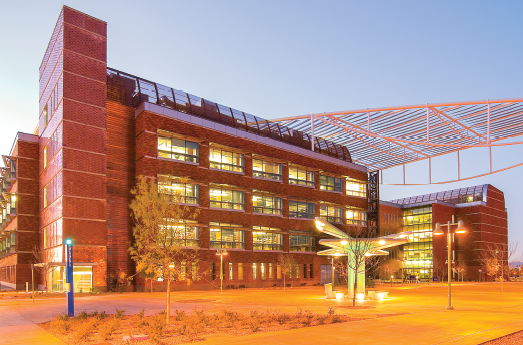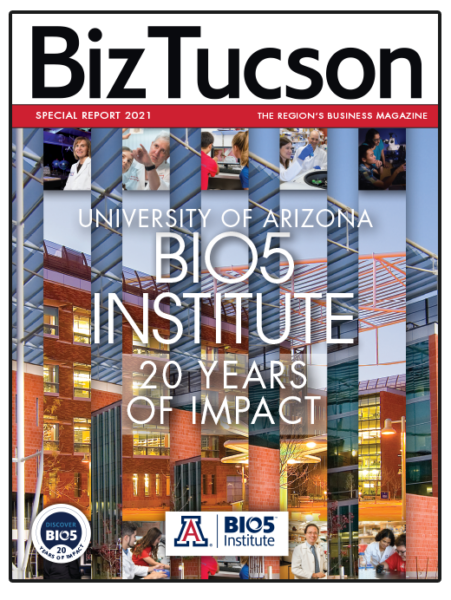
University of Arizona BIO5 Institute 20 Years of Impact
Collaborative Research Leads to Important Solutions
By Romi Carrell Wittman
The BIO5 Institute, the University of Arizona’s crown jewel of discovery, research and innovation in the biosciences, turns 20 years old this year. It’s a landmark achievement, and one that has resulted in major interdisciplinary advances in bioscience, biomedicine and biotechnology.
BIO5 began as a simple yet innately complex idea: Serve as a hub for collaborative research that would produce bold and innovative solutions to complex biological challenges like aging, hunger, disease, water and food sustainability, and other public health issues. The idea was not to build something around a single discipline or simply to house people with different disciplines in the same building. The goal was to tackle major challenges affecting humankind by leveraging and bringing together five core disciplines at UArizona: agriculture, engineering, medicine, pharmacy and basic science.
Peter Likins, UArizona president from 1997 to 2006, and UArizona benefactor Thomas Keating were instrumental in getting BIO5 off the ground. Likins’ vision was to create a place – a physical environment – as well as a collaborative culture, that would bring together and nurture researchers from different fields, clearing the way for new innovations and breakthroughs that might otherwise not be found.
“It became evident … that the opportunity for advancement wasn’t in a (single) core discipline, but in the interface between disciplines,” Likins said. “Interdisciplinary research was in the air. The climate was right to create BIO5, and that’s important because not every university has that.”
Keating, a longtime volunteer and donor to UArizona, said Likins and Eugene Sander, then dean of the College of Agriculture and Life Sciences and vice provost, approached him about the “project” that would become BIO5. “I well understood the concept of collaborative research,” Keating said of his interest in this project.
Likins said Keating’s support was critical. “We needed leadership, and Thomas Keating helped us get across the finish line.” While Keating provided much of the initial funds to get the project off the ground, it was apparent the entity would need a permanent funding source if it was to survive.
Likins, in partnership with Arizona State University President Michael Crow and the Arizona Board of Regents, approached the Arizona Legislature about instituting a sales tax to fund biological research at each of Arizona’s three state universities. Initially, the concept was met with a great deal of resistance. Likins and Crow lobbied hard for the funding, making the argument that this research could lead not only to scientific breakthroughs, but also commercialization and other knowledge-based, Fourth Industrial Revolution – 4IR – global economic opportunities.
Ultimately, a 0.6% sales tax increase was approved by Arizona voters in 2000 which resulted in funding for K-12 initiatives as well as higher education. Called the Technology and Research Initiative Fund, or TRIF, each of Arizona’s three universities use their portions to promote university research, development and technology transfer related to the knowledge-based global economy.
With all the stars in alignment, BIO5 launched in 2001 and Vicki Chandler served as its first director. “Vicki was the MVP of the operation,” Likins said. “She was in there with a hardhat making sure they built it right. She influenced the building’s creation to make sure it worked well for everyone. We started with a world-class facility that gave us an edge.”
During her seven-year tenure, Chandler not only oversaw development and construction of BIO5’s state-of-the-art facility on the UArizona campus; she also helped build a critical research infrastructure. After she stepped down to focus on other research, physcian-researcher Dr. Fernando Martinez was named the new BIO5 director.
“I became director in 2009 at the height of the financial crisis. I knew there would be large budget cuts, but I accepted that because I was highly enthusiastic about the BIO5 idea,” Martinez said.
Martinez looks back on his service fondly, especially his work with UArizona’s then VP for Research Leslie Tolbert and the deans of the five founding colleges of BIO5. “Nothing is more important for progress in science than bringing together the best scientists,” he said. “Seeing so many faculty thrive and excel in translating their knowledge into instruments to improve human health and well-being, many of them housed in the Keating building, is by far my fondest memory.”
Jennifer Barton took the BIO5 reins in 2015. A professor of biomedical, electrical, computer and biosystems engineering, optical sciences and medical imaging, Barton said BIO5’s mission is more critical than ever. Resilient aging, microbiomes, infectious diseases, technology for health, and precision medicine are just some of the areas BIO5 researchers are addressing.
When asked which element of BIO5 is her favorite, Barton said that’s like a parent trying to choose a favorite child. Rather, she said, the people and culture of BIO5 resonate deeply with her. “The fantastic investigators we get to work with, the trainees that have come out of our labs and have gone on to prestigious positions at labs around the world – BIO5 isn’t a degree-granting organization, but we train thousands of people each year,” she said.
While BIO5 may not confer degrees, it plays a large role in educating and training the next generation of scientists. Its KEYS Research Internship is a seven-week summer program for Arizona high school students who have an interest in STEM (science, technology, engineering and mathematics). They work alongside top UArizona faculty on active research projects. Past interns have contributed to research developing better ways to detect and treat diseases like Alzheimer’s, cancer, asthma and diabetes. Nearly 600 students from across the state have completed KEYS since it began in 2007, with more than 60% coming from backgrounds traditionally underrepresented or underserved in STEM degrees and careers.
BIO5’s impact goes well beyond advances in biological research or training of future scientists and researchers. UArizona estimates BIO5 is directly responsible for bringing $1 billion to the Arizona economy, including the launch of 55 new spin-out companies.
BIO5 was drastically affected by the COVID-19 shutdown and for a time the building operated with critical personnel only while safety protocols were established regarding number of people allowed in spaces, sanitization, distancing and masking.
Faculty and staff established ways to keep work progressing without coming into the labs. Barton said, “Our investigators are wonderfully creative. It was quite challenging, but there were many bright spots.”
BIO5 played a large role in the university’s pandemic response. Betsy Cantwell, senior VP for research, innovation and impact at UArizona, said, “BIO5’s efforts to address the COVID-19 pandemic are a shining example of how this institute offers critical leadership, know-how and scientific discovery when and how it is most needed.”
BIO5 quickly deployed a round of competitive seed grants for the sole purpose of quick-starting COVID-19 research capacity. Thirteen projects were selected based on their goal to help the people of Arizona, potential return on investment and team-based approach. Funded project areas included the development of novel therapeutics; tracking and prediction of disease spread; prediction of patient needs; exploration of the virus’s survivability in specific environments; understanding immunologic risk factors for severity of COVID-19; and promotion of wellness during social isolation.
UArizona President Robert Robbins said it’s BIO5’s very nature that enables it to pivot quickly, as it did during the pandemic. “The BIO5 strategy takes advantage of the rapid change around us, aggregates diverse expertise and knowledge, and prepares students for future success by integrating them into transformational learning experiences.”
Barton is excited for the opportunities that lie ahead, among them getting the word out to companies and industry that might benefit from the Keating Bioresearch Building’s state-of-the-art environment. “I still run into people in Tucson that don’t realize that we have fantastic facilities and equipment for them to use,” she said. “We have investigators with deep expertise here to help and partner.”
Cantwell said BIO5 is a critical element in UArizona’s research and innovation ecosystem and is a vital part of UArizona’s land-grant mission. “By partnering with many UArizona colleges, departments, centers, institutes and innovation allies including Tech Launch Arizona, BIO5 translates research to the marketplace where it can be readily used to help humankind.”
Robbins said BIO5 is critical to UArizona’s core mission of continuous improvement in education and innovation, something he said is necessary to develop the next generation of adaptive problem solvers capable of tackling the huge challenges facing the world. “BIO5 has had an incredible impact both locally and beyond,” Robbins said. “I am incredibly proud to be celebrating BIO5’s 20 years of excellence.”






